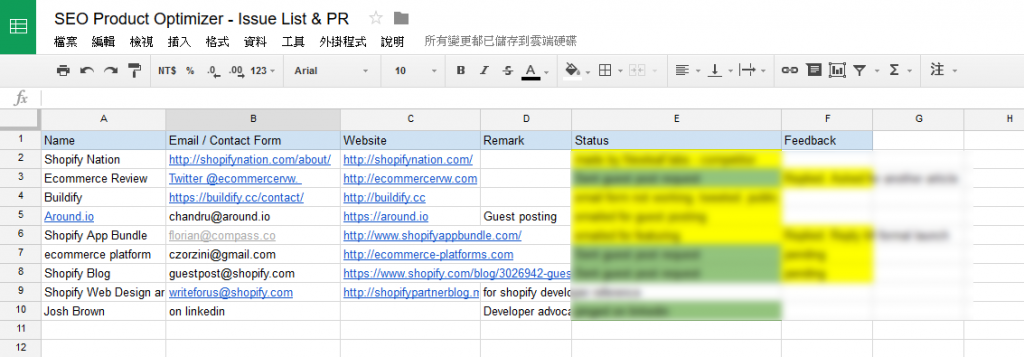This post comes after Why did we develop a small Shopify App? Since 16/12/2016 Our Shopify App – SEO Product Optimizer (SPO) had launched on Shopify App Store. We were happy that our works had finally released to the public. This was a very exciting moment to see how the market reacted to our concepts.
Originally we planned to finish the app within 3 months. We made it within 2 months… However Shopify App Team took around 3 weeks to finish reviewing our app to beta testing. We spent the extra time on testing and pre-marketing. Finally we finished reviewing on 15/12/2016. Phew! We could search it on the Shopify App Store.
Note: According to the FTC disclosure requirement, there are affiliate links included in the post. By clicking the links, I will earn commissions at no cost to you. Also, the links are essential to start a successful project.

Now it’s time to do more marketing instead of coding. We have sent our app to a list of related communities we curated on a Google Sheet. With a very limited budget I would like to get around 1,000 beta users before we formally charge for a monthly subscription fee.

Purpose of this series:
I have been reading various blogs like the Buffer Blog, Noise vs Signals, BugMuncher Blog (Love this founder, quite fun). I believe in the philosophy of transparency creates trust. It may look stupid to reveal our numbers to the public. This may lead to our competitors following our strategy easily.
But I don’t think any existing players will feel nervous of a small player like us. We’re just too small like a peanut. The purpose of this series will be
- Help other bootstrappers and solo founders like me
- Share our values with the others
- Clear my thoughts for the next step
- Bootstrapping our app to a stable income business
- I have been failing for too many fucking times. This writing makes me feel less scared. It’s more about psychology & my personal stuffs.
The marketing tactics we used in the last month:
I was doing marketing with the following ways:
- SPO Product Website
we put our branding and product information on a standalone website. But it could not drive much traffic. Anyway at least we’d got a place where our app could be found out from search engines.
. - Replying relating questions on communities or forums
Not much traffic received as well. We answered relevant questions on Shopify community or Reddit. Unfortunately Shopify community was not very active among store owners. We could find many questions that could be solved by our App. But I didn’t see much traffic coming in.
.
On the contrary, Reddit communities were very active. I subscribed to subreddits like startup, entrepreneur, ecommerce, Shopify and even SideProject. Redditors are very helpful. They gave valuable opinions regarding my launch and marketing strategy.
. - Guest post requests sent to related media. Not much feedback received. There aren’t many blogs about Shopify. I am not sure if it’s because of my poor PR pitching skill, though I didn’t reach famous media like TNW, TechCrunch. Dan at EcommerceRVW were quite helpful. The site was founded by 2 cofounders named Dan. Awesome.
. - Engineering marketing
A small web app called http://come.toTheTerminal.com was developed. The simple web app helps users sharing a URL on Facebook with a custom title, description and image in breeze. If users just wanna have a quick share of their website, they no longer need to change their codes about social meta tags.
.
It drove 400 users to this web app. The user spike made the server broke down for a moment. We fixed the server issue immediately after locating it’s a database problem. We installed StatusCake to notify us whenever it happened again (Hopefully Not!). It’s also a good thing because it won’t bother our real users when the app is formally launched in the short future.
. - User action recording with Hotjar
As I was not sure whether our onboarding process could help our new customers, I set up Hotjar to see if the new customers could follow our instructions. Out of my expectation, most customers could understand our thoughts. Some of them might spend more than 1 or 2 hours at the 1st time. I had watched carefully for some samples. Indeed there were stupid setups wasting users time. We would include the enhancement & bug fixes in the next update.
.
Hotjar was indeed very useful to understand how users interacted with our software. I no longer need to make any wild guess or asking users via email.
. - Install Google Analytics (GA) into SPO website, blog, Shopify listing page, inside the app
This is a basic move to track conversions from various channels to actual app install. Page views mean nothing if there is no actual install. We value the most important metric as users going from Shopify App listing page to install ratio.

Summary of Tools I used so far:
- Metrics measurement
- Google Analytics: free. tracking traffics from various
- Hotjar: free. Recording user action in apps
- Support
- Pure Chat: free. Live chat with SPO website users
- Helpscout: $35 / month. Knowledge Base for FAQ. Instant help menu in App. Most users submit support tickets here. So I guess the experience is quite good. The free plan was cut in 2019. I use it to host 2 support sites. After the annual ends, I will switch to the $20 plan soon.
- Design
- Infrastructure
- Bitbucket: free. Code management
- Asana: free. Project management
- StatusCake: free. Notification about web service status
- SendGrid: free. Transaction & Drip email triggered in SPO App
- Digital Ocean: 2 Cloud Servers: $10 / month in total. for SPO blog, website, app. One for development, one for production. I’ve upgraded the production server to 2GB RAM for $10 / month.
- Namecheap: I bought the domain here. user-friendly interface. Didn’t give me any trouble.
- Cloudflare: free. CDN & DNS. I will migrate the domain to Cloudflare to enjoy the cheapest domain renewal fee.
- Bug tracking (added in 2020)
- Sentry: Given that I am using the free version, I am very happy with the value it provided. It mainly helps to track django exceptions, though you can set django to send you auto notifications. Sentry provides more user info like browser version, country, etc.
- Others
- Godaddy email: free gift when I purchased domain. Though the mail client interface is like shit, it works.
- WordPress: free. SPO blog
- Mailchimp: paid per email sent. My list got more than 2,000 subscribers (for my consulting business). Marketing emails to SPO users.
- ConvertKit & TinyLetter: since Mailchimp is expensive now, I tried them for substitution (updated in 2020)
p.s. forgive me as I don’t know how to use table in wordpress :(.
Some Discovery about the marketing results:
- 117 active installs made since launch, 30 uninstalls
- Good things
- Low uninstall rate
Our install rate is very high, nearly 70% since our launch. The remaining 30% uninstall rate is probably due to the installation of liquid code into the Shopify theme. The small task is intimidating for non-techie store owners. However this is limited by a strange software architecture of Shopify. We cannot do much to eliminate this task. We received many inquiries about liquid code installation via email. However the app is free at the moment. So users didn’t have a cost to install or uninstall it. - High session time
Many users will spend long time (say 1 – 2 hours) using our app even the first time. We discovered the interesting facts in Hotjar. These hard working users will go through all products 1 by 1, just like what our instructions told them. I can say that users can follow 80 – 90% of our onboarding process.
- Low uninstall rate
- Bad things
- Low Retention
Users may not frequently come back after working on products. If we want users coming back after a while, we need to give users a good reason. Otherwise the retention will be kept low. Users will eventually uninstall the app if they didn’t open our app for a long time. - Very Slow Growth Rate
The user growth rate is very slow, just 5 – 7 more installs per day. More marketing works are required. I am not sure if this is because Shopify app user base is small or our marketing effort is not enough. If it’s the former case, we may need to expand our target market to websites other than Shopify stores.
- Low Retention
Monthly Subscription not likely a good revenue model?
One thing I doubt is whether monthly subscription is a good model for SEO. Many users just edit the products once and they are done. My initial plan was to create stable income via monthly subscription. There are around 200K stores. 50% are our target market, i.e. 100K stores. If we can get 1% of stores to pay for our app, there will be 1,000 customers. Each of them we’ll charge for $10 – $15 / month. That’s already a stable business in my region. If I am going to charge by monthly subscription, I need to make users coming back regularly. Not very confident it can be done at the moment.
I am afraid turning from free to subscription will be a deal breaker. If it’s not working, I may go to freemium model by selling value added service. A freemium model also requires a large user base in order to convert free users to paid users. The current user base may be too small to for freemium monetization. I need a moment to think about the issue. Obviously we cannot hit product market fit at this moment.

What’s next?
In the next month, I will try to increase the user base to 500 – 1,000. The current marketing channels are too narrow. We are unlike other SaaS apps with frontend features that can enjoy additional organic growth for more users.
We will investigate a viral loop to have positive organic growth. Otherwise we must die after few months according to the current growth rate. Not cool.
Mind sharing your marketing strategy?
How do you get your app to the market? Did you have a good business as a Shopify app developer? Feel free to drop me a note at [email protected]

One thought on “From 0 to 0.1: the Journey of Bootstrapping a Small Ecommerce Plugin to a Scalable Business (Part 1)”
[…] Our Shopify App – SEO Product Optimizer (SPO) had launched on Shopify App Store. How can we bootstrap our little app to a money making business? – Read full story at Hacker News […]
From 0 to 0.1: the Journey of Bootstrapping a Small Ecommerce Plugin to a Scalable Business (Part 1) - The SEO Product Optimizer Blog